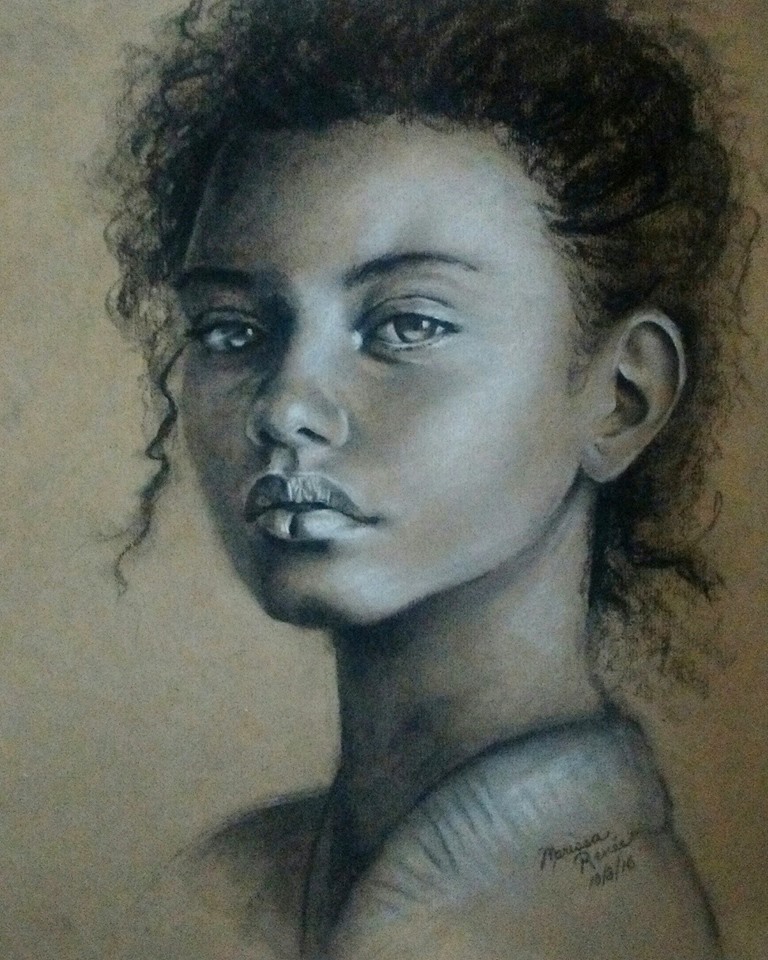
Our 18-year-old daughter Marissa Renée is a professional portrait artist who never took a “real” art class in her life. Part of her success is sheer determination, part is remarkable talent, and part is the art experiences of her youth. To spark some ideas if your own artist is budding and your budget isn’t, I’ll take you on our children’s art journey.
First, a caveat:
Marissa is a very determined artist. From little on she has worked hard on her craft. She takes criticism well, is eager to learn, and is patient with her pencil. She also has a large amount of natural ability and takes the time to study lines on faces. As she says, it’s more about seeing lines than getting them down on paper—observe, observe, observe.
Now let’s mosey down our family’s art path.

Exposure
Everyone from my baby onward is exposed to a wide array of excellent artwork from the moment they first blink those sweet baby blues. I am an incurable word nerd, so I choose my children’s books carefully. An excellent book may be tossed aside, however, if the illustrations are not a thing of beauty.
Before we traded our house and four walls for the open road and a traveling music mission, we decorated almost every room with quality art, while the kids’ artist grandma painted murals on their bedroom walls. We filled cheap frames with old calendar pages—our favorites are Cassatt and Monet. We printed classics off the internet to frame and occasionally bought an affordable print. One year my mom sent us a Degas ballerina statue that lived on our piano and which eventually triggered an interest in sculpting. Gifts, upcycles, printables, and affordable art kept beautiful artwork in front of our children every day.
Of course, free art museum days are always another option, but we generally avoid them. Big crowds, eight kids, sensitive toes, no thank you. What we do haphazardly visit, however, are art stores, fairs, competitions, galleries, and shows—all free.
Some libraries let you check out artwork for a month at a time. That opportunity provides a variety of changing pieces for your wall and your child’s eyes. Your eyes, too, of course, after your coffee opens them.

Expense
We keep quality, but still affordable art supplies on hand. (Prismacolor and General are readily available brands my daughter still uses at a professional level.) We’ve always given them as gifts, so the money came out of the gift budget—my kids tell me that’s cheating, but I think they’re okay with it, because they still ask for art supplies for Christmas…and a puppy.
Don’t let budget get in the way. Marissa reminds me that she began sketching with #2 pencils, and she used good ol’ #2 pencils for some of the pictures you see here, and her older sister Hannah added that a favorite sketchpad was their math book. Free access to their own pencils, a cheap sketch pad, and a box of 50-cent crayons has resulted in shelves of picture books by our two oldest, who are now an artist and a writer.
Experience
Marissa says that the main way she learned to draw face was by making eye contact all the time. She cautions that when you over-study someone’s face, especially after that person has stopped talking to you, it gets a little awkward. For that reason, let me suggest some alternative that we also pursued.
There is a mass of art curricula available today. I’ve drooled over much of it and tested a few art books over the past 20 years. I have a few favorites—it’s all based on personal preference, so I won’t recommend them. The one book, however, that made all the cuts and is with us in our tiny travel trailer today is a thin little pamphlet called Drawing Textbook by McIntyre. It teaches art skills…not how to draw a horse or car or anime but how to draw shapes, use perspective, shade, add depth, and make a tree look like a tree. (There are others that teach skills and include faces. Admittedly, I have some I personally like better, but McIntyre’s pamphlet is tiny and affordable and has taught us well.) Anyone with the basic skills can carry himself far…or in my case far enough to draw a pretty decent birthday cake on a card, so if you choose one book, select one that teaches skills, not merely how to draw a cat.
Also, there are numerous online art courses for homeschooled children. Many offer a sample lesson or two—take the lessons! If your child loves them, put the course on a Christmas list. If it’s too expensive or they’re ambivalent, move on. We never pursued the online courses beyond testing them out for free. If my children show interest in a certain area of art, I give them art books—for Marissa, that area was portraits. Walter Foster and Lee Hammond are two that we favor for their instructive benefits (and Foster’s amazing drawing), but anything you can find for 50 cents at a Friends of the Library sale could work just as well! If the child hates it, donate it…or if you also have eight kids, pass it down. This is important, so I’m going to say it again—if your child hates it, write off the 50 cents or $20 and pass it on! You could be saving them from a lifetime of art-hating.
It’s confession time. I have never finished an art book with my kids. Nope. Never in 20 years. I know—I’m an unfit mother, but seriously…we did art in the kitchen and that’s really close to the pantry where the chocolate chips were kept and that just screamed cookies. (Hannah says that’s why my kids are all great at fractions and baking…which they are.) Don’t judge.
Enthusiasm
We always keep art class fun—it’s once a week, low pressure, and nobody who tries failed. It isn’t like math, where there are right and wrong answers. (That blob of paint and bubble gum really could be a pumpkin and a princess.) There are, however, tips that can be added: sketch lightly so you can erase, remember what we learned about shading, define your light source. Marissa rarely needed those tips, but others sometimes do, and they are given gently to a child who is truly trying. For the occasional child who obviously isn’t even trying, I say, “You’re obviously not even trying,” which I’m told is unpopular parenting, so don’t copy me. I follow that up with, “Let’s try this together,” and we have a do-over.
Personal improvement is huge. Each child has an art notebook and is taught to date each piece and work in page order (instead of randomly drawing on whichever page it opens to, which for some reason is their natural propensity—chaos is fun!). Being able to go back and notice improvement is a strong motivator to keep on working.

Experts
Art lessons did happen in our home, but I was the teacher. My mother is an artist, my husband and one brother are artistically talented, and several of my children show amazing talent or promise. Who’s missing from that list? Oh, that’s right—I am. I have as much art talent in my entire body as my two-year-old has in his little toe. I’m telling you this to give you hope that you do not need expensive classes and professional teachers for your child to learn. You don’t even need talent.
Of course, outside people are helpful. Periodically we meet an art instructor or artist and ask them for some tips or guidance. They give an honest assessment of Marissa’s talents from, you know, someone other than Mom and Dad. This is important, because of a little thing called reality.
Marissa is blessed to have her grandmother, who is also a professional artist, although in a different style. They chat art and admire each other’s projects, sometimes sharing tips and encouragement. Marissa’s siblings are blessed to have Marissa offer them guidance.
We took advantage of our local fair by entering artwork (and cookies, of course). Marissa’s judges were “invisible,” so she never learned from them how she could improve. Other judges we’ve experienced through 4-H will talk to the child face-to-face.
Some experts are either long gone or digital. There are times during our art studies when we recreate works by the masters. Often when Marissa sees a technique that she wants to recreate, she watches time-lapse videos on YouTube. YouTube is like…well, like a great big vat of potentially helpful and potentially horrible resources, so use with care and supervision, but don’t ignore its enormous potential for free art lessons!
A note on encouragement from my children:
If your child is enthusiastic but has no natural ability, don’t give them an unrealistic idea of their skills. Encourage them, teach them the basics of drawing so they can improve, but don’t flatter. Not everyone is a Rembrandt—most of us are undiscovered Picassos.
I want to summarize what probably seems like a couple decades of throwing around art supplies, plastering Monets on the wall, using the gift budget to buy homeschool materials, and never finishing an art book ever. What we really did was…well…that is what we really did. If you look realistically at your child’s skills, you can see 1) if they have potential, and 2) where they need encouragement or another tool to move forward. Use what is at your disposal to make that improvement happen—the eccentric artist next door (bring him cookies and rake his yard), the 25-cent art books at a garage sale, art shows, quality exposure, but mostly, a positive attitude and hard work.
 Author bio: Christy Bagasao and her family of 10 travel the USA full-time in a 33-foot travel trailer for their Christian music mission. She shares their adventures at The Travel Bags and also writes about simplifying life at The Simple Homemaker.
Author bio: Christy Bagasao and her family of 10 travel the USA full-time in a 33-foot travel trailer for their Christian music mission. She shares their adventures at The Travel Bags and also writes about simplifying life at The Simple Homemaker.
—oOo—
